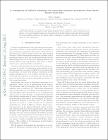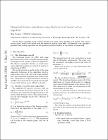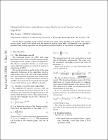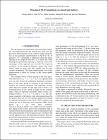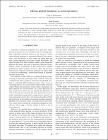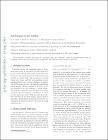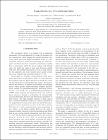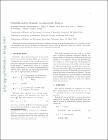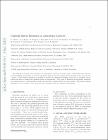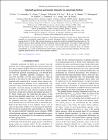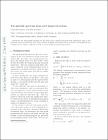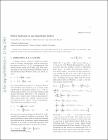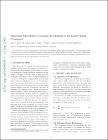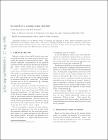Browsing by Author "PEARDON, MICHAEL JAMES"
Now showing items 7-26 of 43
- Sort by:
- title
- issue date
- submit date
- Order:
- ascending
- descending
- Results:
- 5
- 10
- 20
- 40
- 60
- 80
- 100
-
Coarse lattice results for glueballs and hybrids
PEARDON, MICHAEL JAMES (Elsevier, 1998)A review of new results from lattice simulations of glueballs and heavy-quark hybrid mesons is presented. -
Comparison of analysis techniques for extracting resonance parameters from lattice Monte Carlo data
PEARDON, MICHAEL JAMES; MC MANUS, DARRAN (2012) -
Dynamical fermion simulations of QCD on anisotropic lattices
PEARDON, MICHAEL JAMES (Elsevier, 2004)Simulations of QCD with two flavours of improved Wilson quarks on an anisotropic lattice are discussed. Methods for improving the performance of the Hybrid Monte Carlo (HMC) algorithm in these studies are described. -
Dynamical fermion simulations using Luscher's local bosonic action algorithm
PEARDON, MICHAEL JAMES (Elsevier, 1995)The two-flavour Schwinger model is used to test the local boson action algorithm of M Luescher. The autocorrelation time is found to rise linearly with the number of auxiliary boson fields. An extension to the algorithm ... -
Dynamical QCD simulations on anisotropic lattices
PEARDON, MICHAEL JAMES; RYAN, SINEAD MARIE (2006)The simulation of QCD on dynamical ( N f 2 ) anisotropic lattices is described. A method for nonperturbative renormalisation of the parameters in the anisotropic gauge and quark actions is presented. The precision ... -
Efficient glueball simulations on anisotropic lattices
PEARDON, MICHAEL JAMES (American Physical Society, 1997)Monte Carlo results for the low-lying glueball spectrum using an improved, anisotropic action are presented. Ten simulations at lattice spacings ranging from 0.2 to 0.4 fm and two different anisotropies have been performed ... -
Excitations of the torelon
PEARDON, MICHAEL JAMES (Elsevier, 2004)The excitations of gluonic flux tube in a periodic lattice are examined. Monte Carlo simulations from an anisotropic lattice are presented and the comparison with effective string models is discussed. -
Excited and exotic charmonium spectroscopy from lattice QCD
RYAN, SINEAD MARIE; PEARDON, MICHAEL JAMES (2012)We present a spectrum of highly excited charmonium mesons up to around 4.5 GeV calculated using dynamical lattice QCD. Employing novel computational techniques and the variational method with a large basis of carefully ... -
Excited D and Ds meson spectroscopy from lattice QCD
PEARDON, MICHAEL JAMES; RYAN, SINEAD MARIE (2012) -
Excited spectroscopy of charmed mesons from lattice QCD
RYAN, SINEAD MARIE; PEARDON, MICHAEL JAMES (2013)We present spectra of highly excited D and D s mesons up to around 3.8 GeV determined using dynamical lattice QCD. We employ novel computational techniques and the variational method with a large basis of carefully constructed ... -
Gauge theories on a 2+2 anisotropic lattice
PEARDON, MICHAEL JAMES; RYAN, SINEAD MARIE (American Physical Society, 2003)The implementation of gauge theories on a four-dimensional anisotropic lattice with two distinct lattice spacings is discussed, with special attention to the case where two axes are finely and two axes are coarsely discretized. ... -
Glueball matrix elements on anisotropic lattices
PEARDON, MICHAEL JAMES (Elsevier, 1998)We describe a lattice calculation of the matrix elements relevant for glueball production in J/ radiative decays. The techniques for such a calculation on anisotropic lattices with an improved action are outlined. We ... -
Glueball matrix elements on anisotropic lattices
PEARDON, MICHAEL JAMES (Elsevier, 2004)The glueball-to-vacuum matrix elements of local gluonic operators in scalar, tensor, and pseudoscalar channels are investigated numerically on several anisotropic lattices with the spatial lattice spacing in the range ... -
Glueball spectrum and matrix elements on anisotropic lattices
PEARDON, MICHAEL JAMES (American Physical Society, 2006)The glueball-to-vacuum matrix elements of local gluonic operators in scalar, tensor, and pseudoscalar channels are investigated numerically on several anisotropic lattices with the spatial lattice spacing ranging from ... -
Glueball spectrum from an anisotropic lattice study
PEARDON, MICHAEL JAMES (American Physical Society, 1999)The spectrum of glueballs below 4 GeV in the SU~3! pure-gauge theory is investigated using Monte Carlo simulations of gluons on several anisotropic lattices with spatial grid separations ranging from 0.1 to 0.4 fm. Systematic ... -
The glueball spectrum from novel improved actions
PEARDON, MICHAEL JAMES (Elsevier, 2000)Results for the inter-quark potential and low-lying SU(3) glueball spectrum from simulations using a new improved action are presented. The action, suitable for highly anisotropic lattices, contains a two-plaquette ... -
Heavy hadrons on an anisotropic lattice
PEARDON, MICHAEL JAMES; RYAN, SINEAD MARIE (Elsevier, 2004)Results from simulations of quarkonia and heavy-light mesons on an anisotropic lattice are presented. The improved quark action and action-parameter tuning used in this study are discussed. -
High performance scientific computing using FPGAS with IEEE floating point and logarithmic arithmetic for lattice QCD
PEARDON, MICHAEL JAMES (IEEE, 2006)The recent development of large FPGAs along with the availability of a variety of floating point cores have made it possible to implement high-performance matrix and vector kernel operations on FPGAs. In this paper we seek ... -
Improving Algorithms to Compute All Elements of the Lattice Quark Propagator
PEARDON, MICHAEL JAMES; RYAN, SINEAD MARIE; SKULLERUD, JONIVAR (Elsevier, 2005)We present a new exact algorithm for estimating all elements of the quark propagator. The advantage of the method is that the exact all-to-all propagator is reproduced in a large but finite number of inversions. The ... -
In search of a scaling scalar glueball
PEARDON, MICHAEL JAMES (Elsevier, 1999)Anisotropic lattices are an efficient means of studying the glueballs of QCD, however problems arise with simulations of the lightest, scalar state. The mass is strongly dependent on the lattice spacing, even when ...





